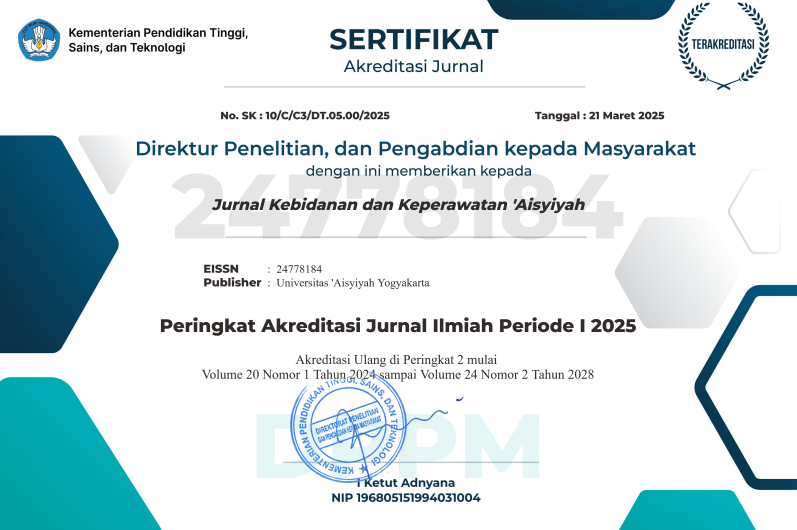Korelasi cara bersalin dengan depresi postpartum
DOI:
https://doi.org/10.31101/jkk.995Abstract views 2313 times
Keywords:
cara persalinan, depresi, postpartum, EPDSAbstract
Downloads
References
Abdollahi, F., & Zain, A. (2015). The mode of delivery and some selected obstetric factors as predictors of post-partum depression, 1(2), 14–22.
APA & ACOG. (2012). Guidelines for Perinatal Care. American Academy Of Pediatric and The American College Of Obstetricians an Gynecologist.
Arbabi, M., Taghizadeh, Z., Hantoushzadeh, S., & Haghnazarian, E. (2016). Journal of Womens Health Care Mode of Delivery and Post-partum Depression : A Cohort Study. Journal of Womens Healt Carae, 5(1), 1–5. https://doi.org/10.4172/2167-0420.1000303
Beck, C. T. (2001). Revision of the Postpartum Depression Predictors Inventory. Journal Of Obstetri, Ginecologic & Neonatal Nursing, 31(4).
Beck, C. T. (2002). Revision of the Postpartum Depression Predictors Inventory. Journal of Obstetric Gynecologic and Neonatal Nursing, 31(4), 394–402. https://doi.org/10.1111/j.1552-6909.2002.tb00061.x
Begum, B., Zaman, R., Rahman, A., Uddin, M., & R, H. (2009). Comparison of Risk and Benefits of Normal Vaginal and Caesarian Section Deliveries in a Public Tertiary Hospital in Bangladesh. Mymensingh Med, 18.
Borra, C., Iacovou, M., & Sevilla, A. (2015). New Evidence on Breastfeeding and Postpartum Depression : The Importance of Understanding Women ’ s Intentions, 897–907. https://doi.org/10.1007/s10995-014-1591-z
Burgut, F. T., Bener, A., Ghuloum, S., & Sheikh, J. (2013). A study of postpartum depression and maternal risk factors in Qatar. Journal of Psychosomatic Obstetrics & Gynecology, 8942(2), 90–97. https://doi.org/10.3109/0167482X.2013.786036
Cox, J. L., & Sagovsky, J. M. H. R. (1987). Detection of Postnatal Depression Development of the 10-item Edinburgh Postnatal Depression Scale. British Journal Of Psychiatry, 150, 782–787.
Edwards, G. D., Shinfuku, N., Gittelman, M., Ghozali, E. W., Wibisono, S., Yamamoto, K., … Rappe, P. (2015). Postnatal Depression in Surabaya , Indonesia Postnatal Depression in. International Journal of Mental Health, 1(July), 62–74. https://doi.org/10.2753/IMH0020-7411350105
Ege, E., Timur, S., Zincir, H., Geçkil, E., & Sunar-reeder, B. (2008). Social support and symptoms of postpartum depression among new mothers in Eastern Turkey. Journal Obstetri Gynaecologi, 34(4), 585–593. https://doi.org/10.1111/j.1447-0756.2008.00718.x
Goker, A., Yanikkerem, E., Demet, M. M., Dikayak, S., Yildirim, Y., & Koyuncu, F. M. (2012). Postpartum Depression : Is Mode of Delivery a Risk Factor ? ISRN Obstetrics Ang Gynecology, 2012. https://doi.org/10.5402/2012/616759
Heh, S., Coombes, L., & Bartlett, H. (2004). The Association Betwwn Depressive Symptom And Social Support in Taiwanese Women During The Month. International Journal of Nursing Studies, 41, 573–579. https://doi.org/10.1016/j.ijnurstu.2004.01.003
Herguner, S., Cicek, E., Annagur, A., Herguner, A., & Ors, R. (2014). Association of Delivery Type with Postpartum. Journal of Psychiatry and Neurological Science, 27(1), 15–20. https://doi.org/10.5350/DAJPN2014270102
Hulley, S., Cummings, S., Browner, W., Grady, D., & Newman, T. (2007). Designing Clinical Research Third edition. Philadelpia: Lippincott Williams&Wilkins.
Humayun, Haider, Imran, Iqbal, & Humayun. (2013). Antenatal depression and its predictors in Lahore, Pakistan. Eastern Mediterranean Health Journal, 19(4), 327–332.
Idaiani, S., & Basuki, B. (2012). Postpartum depression in Indonesian women : a national study. Health Science Indones, 3(1), 3–8.
Jardri, R., Pelta, J., Maron, M., Thomas, P., Delion, P., Codaccioni, X., & Goudemand, M. (2006). Predictive validation study of the Edinburgh Postnatal Depression Scale in the first week after delivery and risk analysis for postnatal depression. Journal of Affective Disorders, 93(1-3), 169–176. https://doi.org/10.1016/j.jad.2006.03.009
Klainin, P., & Gordon, D. (2009). Studies Postpartum depression in Asian cultures : A literature review. International Journal of Nursing Studies, 46, 1355–1373. https://doi.org/10.1016/j.ijnurstu.2009.02.012
Liu, A. L., & Yung, W. K. (2012). Factors influencing the mode of delivery and associated pregnancy outcomes for twins : a retrospective cohort study in a public hospital, 18(2), 99–107.
O’Hara, M. W. (2009). Postpartum Depression: What We Know. Journal Of Clinical Psycology, 65(12), 1258–1269.
Olde, E., Hart, O. Van Der, Kleber, R., & Son, M. Van. (2006). Posttraumatic stress following childbirth : A review. Clinical Psycology Review, 26, 1–16. https://doi.org/10.1016/j.cpr.2005.07.002
Robertson, E., Ph, D., Grace, S., Ph, D., Wallington, T., & Stewart, D. E. (2004). Antenatal risk factors for postpartum depression : a synthesis of recent literature. General Hospital Psychiatry, 26(4), 289–295. https://doi.org/http//dx.doi.org/10.1016/j.genhosppsych.2004.02.006
Shamsa, A., Bai, J., Raviraj, P., & Gyaneshwar, R. (2013). Mode of delivery and its associated maternal and neonatal outcomes *, 2013(May), 307–312.
Stewart, D. E., Robertson, E., Phil, M., Dennis, C., Grace, S. L., & Wallington, T. (2003). Postpartum Depression: Literatur Review Of Risk Factors And Intervention. Toronto Public Health, (October).
Swan, J., Tasgin, E., Mayes, L., Feldman, R., Costable, R., & J, L. (2008). Maternal Brain Response to Own Baby Cry is Affected by Cesarean. J.Child Psychol Psychiatry, 49, 1042–1052.
Sword, W., Landy, C. K., Thabane, L., Watt, S., Krueger, P., Farine, D., & Foster, G. (2011). Is mode of delivery associated with postpartum depression at 6 weeks : a prospective cohort study. International Journal of Obstetics and Gynaecology, 966–977. https://doi.org/10.1111/j.1471-0528.2011.02950.x
Wahyuni, S., Murwati, & Supiati. (2014). Faktor Internal Dan Eksternal Yang Mempengaruhi Depresi Postpartum. Jurnal Terpadu Ilmu Kesehatan, 3 No.2, 131–137.
Wahyuntari, E., Hakimi, M., & Ismarwati, I. (2017). Relationship of Social Support with Postpartum Depression in Sadewa Hospital Yogyakarta. International Journal of Science: Basic and Applied Research, 35, 76–84.
Wisner, K. & K. D. (2009). The Identification of Postpartum Depression. Clin Obstet Gynecol, 52(3), 1–12. https://doi.org/10.1097/GRF.0b013e3181b5a57c.The
Yagmur, Y., & Ulukoca, N. (2010). Social support And Postpartum Depression In Low-Sicialeconomic Level Postpartum Women in Eastern Turkey. International Journal Of Public Healt, 55(6), 543–549. https://doi.org/10.1007/s00038-010-0182-z
Downloads
Published
How to Cite
Issue
Section
License
With the receipt of the article by the Jurnal Kebidanan dan Keperawatan Aisyiyah Editorial Board and the decision to be published, then the copyright regarding the article will be diverted to Jurnal Kebidanan dan Keperawatan Aisyiyah. Universitas 'Aisyiyah Yogyakarta as the publisher of Jurnal Kebidanan dan Keperawatan Aisyiyah hold the copyright regarding all the published articles in this journal.
Jurnal Kebidanan dan Keperawatan Aisyiyah is licensed under a Creative Commons Attribution-ShareAlike 4.0 International License.
















